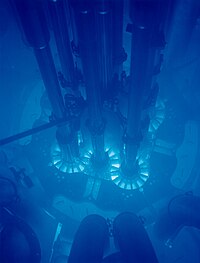
Photo from wikipedia
In extensive air showers induced by ultra-high energy (UHE) cosmic rays, secondary particles are produced with energies far above those accessible by other means. These extreme energies can be used… Click to show full abstract
In extensive air showers induced by ultra-high energy (UHE) cosmic rays, secondary particles are produced with energies far above those accessible by other means. These extreme energies can be used to search for new physics. We study the effects of isotropic, nonbirefringent Lorentz violation in the photon sector. In case of a photon velocity smaller than the maximum attainable velocity of standard Dirac fermions, vacuum Cherenkov radiation becomes possible. Implementing this Lorentz-violating effect in air shower simulations, a significant reduction of the calculated average atmospheric depth of the shower maximum $\left$ is obtained. Based on $\left$ and its shower-to-shower fluctuations $\sigma(X_\text{max})$, a new bound on Lorentz violation is derived which improves the previous one by a factor of 2. This is the first such bound based on the absence of vacuum Cherenkov radiation from fundamental particles (electrons and positrons) in air showers. Options for further improvements are discussed.
Journal Title: Physical Review D
Year Published: 2023
Link to full text (if available)
Share on Social Media: Sign Up to like & get
recommendations!